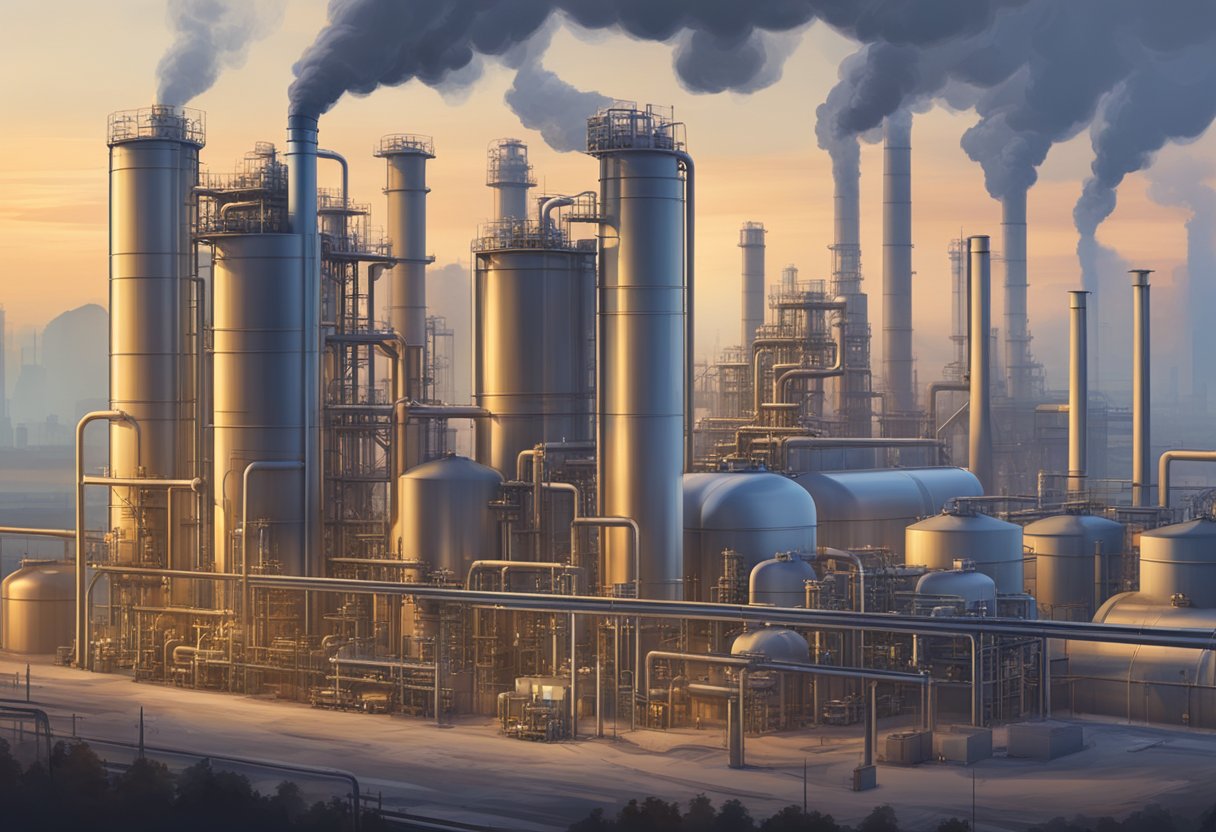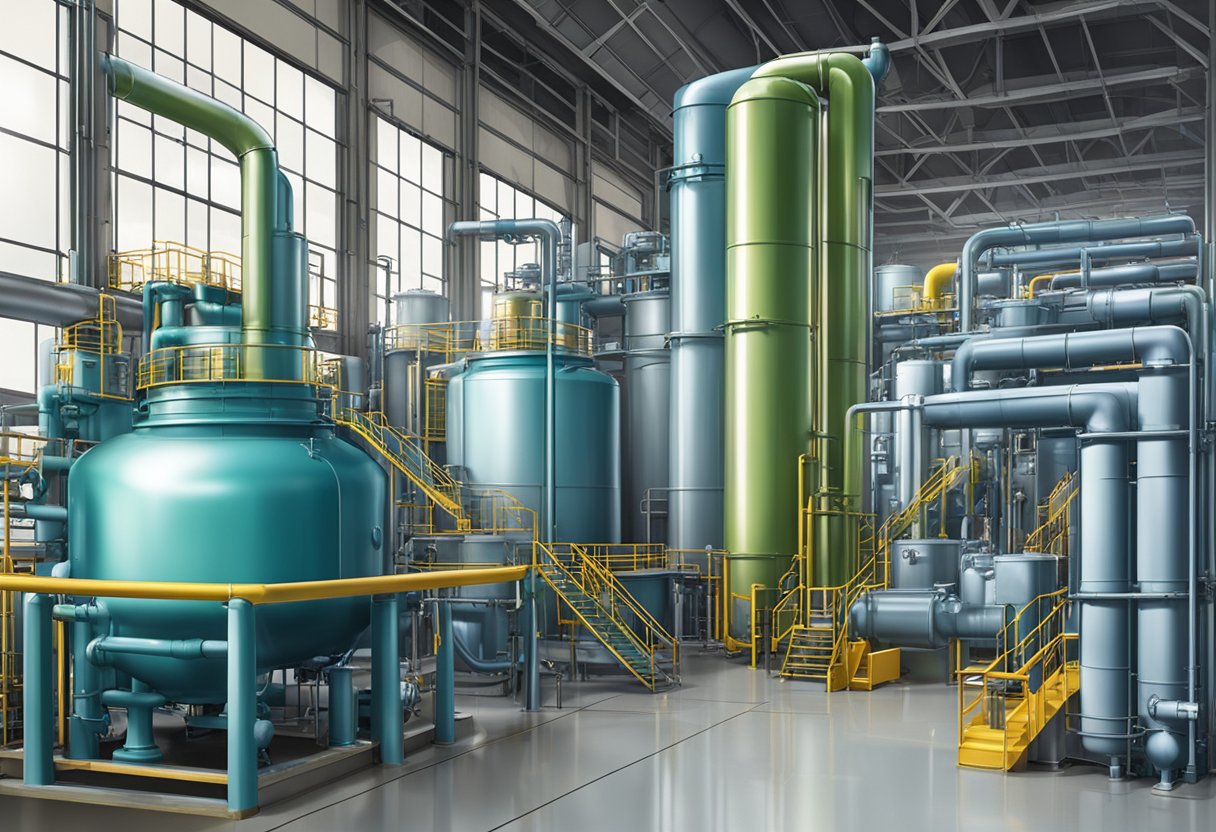Petrochemical Resins: Properties and Applications
19/01/2024
Petrochemical resins are an essential component of modern life. They are widely used in the production of a vast array of products, including plastics, synthetic fibers, paints, adhesives, and many more. These resins are derived from petroleum, which is one of the most widely used natural resources in the world.

The process of producing petrochemical resins involves refining crude oil into various fractions, such as naphtha, which is used as a feedstock for the production of many types of resins. The most common types of petrochemical resins include polyethylene, polypropylene, polystyrene, and polyvinyl chloride (PVC). These resins are used in a wide range of applications, from packaging materials to automotive parts.
Despite their many benefits, petrochemical resins also have some drawbacks. They are not biodegradable and can take hundreds of years to decompose, leading to environmental concerns. Additionally, their production and use can contribute to greenhouse gas emissions and other environmental problems. As such, there is a growing interest in developing more sustainable alternatives to petrochemical resins, such as bioplastics and other renewable materials.
Overview of Petrochemical Resins

Petrochemical resins are a type of synthetic polymer that is derived from petrochemicals. They are widely used in a variety of industries, including construction, automotive, and packaging. These resins are known for their durability, strength, and versatility, which makes them ideal for a wide range of applications.
One of the most common types of petrochemical resins is polyethylene, which is used to make a variety of products, including plastic bags, packaging films, and pipes. Another popular type of petrochemical resin is polypropylene, which is used in the production of automotive parts, medical devices, and textiles.
Petrochemical resins can be produced using a variety of techniques, including polymerization, condensation, and addition reactions. The properties of the resulting resin can be adjusted by changing the type and amount of monomer used in the process.
Some of the key advantages of petrochemical resins include their low cost, high strength-to-weight ratio, and excellent chemical resistance. However, they can also have some drawbacks, such as their dependence on non-renewable resources and their potential impact on the environment.
Overall, petrochemical resins are an important class of materials that have enabled many of the technological advancements of the modern world. Their versatility and durability make them an essential component of many products, and ongoing research and development in this field is likely to lead to even more innovative uses in the future.
Types of Petrochemical Resins

Petrochemical resins are synthetic materials that are widely used in various industries due to their unique properties. They are derived from petroleum or natural gas and can be classified into three main categories: thermoplastic resins, thermosetting resins, and elastomers.
Thermoplastic Resins
Thermoplastic resins are a type of petrochemical resin that can be melted and reshaped multiple times without any significant change in their properties. They are widely used in various applications due to their excellent mechanical strength, chemical resistance, and low toxicity. Some common examples of thermoplastic resins include polyethylene, polypropylene, polyvinyl chloride (PVC), and polystyrene.
Thermosetting Resins
Thermosetting resins are a type of petrochemical resin that undergo a chemical reaction when exposed to heat or pressure, resulting in a permanent change in their properties. They are widely used in various applications due to their excellent mechanical strength, chemical resistance, and high temperature resistance. Some common examples of thermosetting resins include epoxy, phenolic, and melamine resins.
Elastomers
Elastomers are a type of petrochemical resin that can be stretched and deformed under stress and return to their original shape when the stress is removed. They are widely used in various applications due to their excellent elasticity, flexibility, and chemical resistance. Some common examples of elastomers include natural rubber, synthetic rubber, and silicone rubber.
In conclusion, petrochemical resins are essential materials that are widely used in various industries due to their unique properties. Understanding the different types of petrochemical resins can help in selecting the right material for a specific application.
Production Processes

Cracking
Petrochemical resins are produced through a process called cracking. This process involves breaking down hydrocarbon molecules from crude oil into smaller molecules called monomers. This is done by heating the crude oil to high temperatures in a process called thermal cracking. The monomers produced through this process are then used to create various types of resins.
Polymerization
Polymerization is the process of combining monomers to form polymers. In the case of petrochemical resins, the monomers produced through cracking are polymerized to form resins. This is done by adding a catalyst to the monomers, which causes them to react and form long chains of molecules. The resulting polymers can have a wide range of properties, depending on the specific monomers used and the conditions under which they are polymerized.
Polycondensation
Polycondensation is another process used to produce petrochemical resins. This process involves combining two or more monomers with the elimination of a small molecule, such as water or alcohol. This reaction results in the formation of a polymer. Polycondensation is often used to produce polyester resins, which have a wide range of applications in the textile and packaging industries.
Overall, these production processes allow for the creation of a wide range of petrochemical resins with varying properties and applications. The specific process used depends on the desired properties of the resin and the specific monomers available.
Applications of Petrochemical Resins
Packaging
Petrochemical resins have a wide range of applications in the packaging industry. They are used to create various types of packaging materials, including films, bottles, and containers. These resins provide excellent barrier properties, which help to protect the product from moisture, oxygen, and other contaminants. They also offer good strength and durability, making them ideal for use in heavy-duty packaging applications.
Automotive
Petrochemical resins are also widely used in the automotive industry. They are used to create various components such as bumpers, dashboards, and interior trims. These resins provide excellent resistance to impact, heat, and chemicals, which makes them ideal for use in automotive applications. They also offer good dimensional stability, which helps to maintain the shape of the components over time.
Construction
Petrochemical resins are used in the construction industry to create various materials such as adhesives, sealants, and coatings. These resins provide excellent adhesion and bonding properties, which help to create strong and durable structures. They also offer good resistance to weathering, UV radiation, and other environmental factors, which makes them ideal for use in outdoor applications.
Electronics
Petrochemical resins are also used in the electronics industry to create various components such as circuit boards, connectors, and encapsulants. These resins provide excellent electrical insulation properties, which help to protect the components from damage due to electrical voltage, heat, and moisture. They also offer good thermal conductivity, which helps to dissipate heat and maintain the temperature of the components.
In conclusion, petrochemical resins have a wide range of applications in various industries. They offer excellent properties such as strength, durability, adhesion, and electrical insulation, which make them ideal for use in many different applications.
Market Trends and Demand
Petrochemical resins are widely used in various industries, including packaging, construction, automotive, and electronics. The demand for petrochemical resins is expected to grow steadily in the coming years due to the increasing demand for lightweight, durable, and cost-effective materials.
One of the major market trends in the petrochemical resin industry is the shift towards sustainable and eco-friendly materials. Many companies are investing in research and development to create biodegradable and recyclable petrochemical resins, which can help reduce the environmental impact of plastic waste.
Another trend is the increasing demand for high-performance resins, which can withstand extreme temperatures and harsh environments. These resins are used in a wide range of applications, such as aerospace, defense, and industrial equipment.
In addition, the Asia-Pacific region is expected to dominate the petrochemical resin market in the coming years, due to the increasing demand from countries such as China and India. The region has a large consumer base and a growing economy, which is driving the demand for petrochemical resins.
Overall, the petrochemical resin market is expected to continue growing in the coming years, driven by the increasing demand for lightweight, durable, and sustainable materials. Companies that invest in research and development to create innovative and eco-friendly resins will be well-positioned to capitalize on this trend.
Environmental Impact and Sustainability
Biodegradable Resins
Petrochemical resins have been criticized for their negative impact on the environment. However, biodegradable resins have emerged as a sustainable alternative to traditional petrochemical resins. Biodegradable resins are made from renewable materials such as corn starch, vegetable oils, and cellulose. These materials can decompose naturally in the environment, reducing waste and pollution.
Biodegradable resins are becoming increasingly popular for packaging applications. They are used for products such as disposable cutlery, food containers, and shopping bags. These products can be composted, reducing the amount of waste sent to landfills.
Recycling and Recovery
Recycling and recovery are important aspects of the sustainability of petrochemical resins. Recycling involves the collection and reprocessing of used products to create new materials. Recovery involves the extraction of energy from waste materials.
Petrochemical resins can be recycled into a variety of products, including new packaging materials, furniture, and automotive parts. Recycling reduces the amount of waste sent to landfills and conserves natural resources.
Recovery of energy from waste materials is another sustainable solution. Waste materials can be incinerated to generate energy, reducing the need for fossil fuels. However, this process can also release harmful pollutants into the environment.
In conclusion, biodegradable resins and recycling/recovery are important solutions for the sustainability of petrochemical resins. While there are still challenges to overcome, such as the cost-effectiveness of biodegradable resins and the need for improved recycling infrastructure, these solutions offer a promising path forward for a more sustainable future.
Regulatory Framework and Standards
Petrochemical resins are subject to various regulations and standards to ensure their safety and quality. These regulations and standards are enforced by government agencies and industry organizations.
In the United States, the Environmental Protection Agency (EPA) regulates the production, use, and disposal of petrochemical resins under the Toxic Substances Control Act (TSCA). The TSCA requires manufacturers to submit premanufacture notices to the EPA for new chemicals, including petrochemical resins. The EPA evaluates the potential risks of these chemicals and may impose restrictions on their production and use.
In addition to federal regulations, petrochemical resins may be subject to industry standards developed by organizations such as the American Society for Testing and Materials (ASTM) and the International Organization for Standardization (ISO). These standards provide guidelines for the manufacture, testing, and use of petrochemical resins, and help ensure their quality and consistency.
Manufacturers of petrochemical resins must also comply with regulations and standards in the countries where their products are sold. This may include regulations on chemical safety, labeling, and packaging.
Overall, the regulatory framework and standards for petrochemical resins aim to protect human health and the environment, while ensuring the quality and consistency of these important materials.
Innovations in Resin Technology
Resin technology has come a long way since its inception, with new innovations and advancements being made every year. Here are some of the latest innovations in resin technology.
Biodegradable Resins
Biodegradable resins are becoming increasingly popular due to their eco-friendly nature. These resins break down naturally in the environment, reducing the amount of waste that ends up in landfills. They are commonly used in packaging materials, such as bags and containers.
High-Performance Resins
High-performance resins are designed to withstand extreme temperatures and harsh environments. They are commonly used in the automotive and aerospace industries, where the parts need to withstand high stress and pressure. These resins are also used in the construction industry, where they are used to reinforce concrete and other materials.
Self-Healing Resins
Self-healing resins are a new innovation that has the potential to revolutionize the industry. These resins have the ability to repair themselves when damaged, reducing the need for costly repairs or replacements. They are commonly used in the electronics industry, where they can repair damaged circuit boards.
Recyclable Resins
Recyclable resins are designed to be easily recycled, reducing the amount of waste that ends up in landfills. These resins are commonly used in packaging materials, such as bottles and containers. They can be easily recycled into new products, reducing the need for new materials.
Overall, these innovations in resin technology are making the industry more sustainable, efficient, and cost-effective. As technology continues to advance, we can expect to see even more exciting developments in the future.
Supply Chain and Distribution
Petrochemical resins are produced in large quantities by numerous manufacturers worldwide. The supply chain for these products is complex and involves several stages. The first stage involves the extraction of crude oil or natural gas, which is then refined into various petrochemical products, including resins. The resins are then transported to distribution centers or directly to customers.
The distribution of petrochemical resins is a crucial aspect of the supply chain. Manufacturers must ensure that their products reach customers in a timely and efficient manner. This requires careful planning and coordination between manufacturers, distributors, and customers.
Many manufacturers use a combination of transportation methods to distribute their products, including trucks, trains, and ships. The choice of transportation method depends on several factors, including the distance between the manufacturer and the customer, the quantity of product being transported, and the urgency of the delivery.
In addition to transportation, manufacturers must also consider storage and handling of their products. Petrochemical resins are often stored in large warehouses or tanks before being shipped to customers. Proper storage and handling are essential to ensure the quality of the product is maintained during transit.
Overall, the supply chain and distribution of petrochemical resins is a complex process that requires careful planning and coordination. Manufacturers must work closely with distributors and customers to ensure that their products are delivered in a timely and efficient manner.
Challenges in the Petrochemical Resin Industry
The petrochemical resin industry faces several challenges that impact its growth and profitability. Some of the significant challenges include:
1. Fluctuating Prices of Raw Materials
The prices of raw materials such as crude oil, natural gas, and naphtha are volatile and subject to fluctuations. These fluctuations can have a substantial impact on the cost of producing petrochemical resins. The industry must keep up with the changes in prices to maintain profitability.
2. Environmental Regulations
The petrochemical resin industry faces increasing pressure to reduce its environmental impact. Regulations on greenhouse gas emissions, waste disposal, and other environmental concerns can significantly impact the industry’s operations and increase costs.
3. Competition from Alternative Materials
The petrochemical resin industry faces competition from alternative materials such as bioplastics, natural fibers, and recycled materials. These materials are gaining popularity due to their eco-friendliness and sustainability, which is a growing concern among consumers.
4. Technological Advancements
The petrochemical resin industry must keep up with technological advancements to remain competitive. New technologies such as 3D printing and nanotechnology have the potential to disrupt the industry and change the way petrochemical resins are produced and used.
5. Supply Chain Disruptions
The petrochemical resin industry relies heavily on a complex global supply chain. Disruptions in the supply chain due to natural disasters, geopolitical tensions, or other factors can impact the availability and cost of raw materials, transportation, and logistics.
In conclusion, the petrochemical resin industry faces several challenges that require careful management and adaptation to remain competitive and profitable.
Frequently Asked Questions
What are the primary uses of petrochemical resins in various industries?
Petrochemical resins are widely used in various industries, including automotive, construction, electronics, packaging, and textiles. They are used to manufacture a wide range of products, such as adhesives, coatings, films, fibers, plastics, and rubber. Petrochemical resins are valued for their versatility, durability, and resistance to heat, chemicals, and weathering.
How do petrochemical resins differ from other types of resins?
Petrochemical resins are derived from crude oil or natural gas, while other types of resins may be derived from plant sources or synthetic materials. Petrochemical resins are typically more durable and resistant to heat and chemicals than other types of resins. They are also more widely available and cost-effective.
What are some common examples of products made with petrochemical resins?
Petrochemical resins are used to manufacture a wide range of products, including automotive parts, building materials, electronic components, food packaging, medical devices, and textiles. Some common examples of products made with petrochemical resins include plastic bottles, PVC pipes, polyester fabrics, and rubber tires.
Can you provide a comprehensive list of petrochemical resins and their applications?
There are many different types of petrochemical resin, each with its own unique properties and applications. Some common types of petrochemical resin include polyethylene, polypropylene, polyvinyl chloride, polystyrene, and polyurethane. These resins are used in a variety of applications, such as packaging, construction, automotive, and electronics.
How does the production of petrochemical resins impact environmental sustainability?
The production of petrochemical resin can have a significant impact on environmental sustainability. The extraction, refining, and processing of crude oil and natural gas can lead to air and water pollution, habitat destruction, and greenhouse gas emissions. However, many petrochemical companies are working to reduce their environmental impact by investing in renewable energy, improving efficiency, and developing new technologies.
What factors influence the pricing of petrochemical resins in the global market?
The pricing of petrochemical resin is influenced by a variety of factors, including supply and demand, production costs, currency exchange rates, and government regulations. The global market for petrochemical resin is highly competitive, with many large multinational companies vying for market share. Prices can fluctuate rapidly in response to changes in these factors, making it difficult for manufacturers to predict costs and plan production accordingly.




